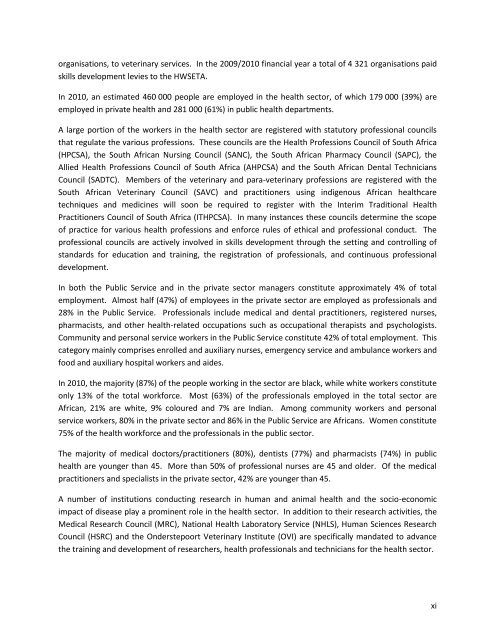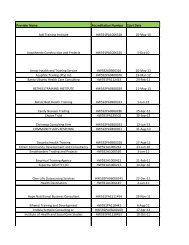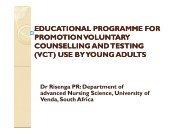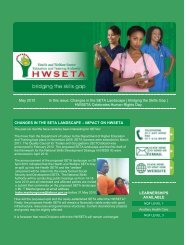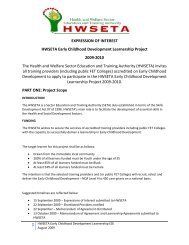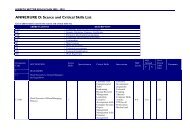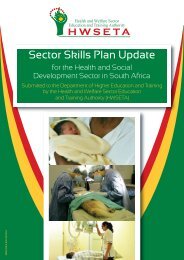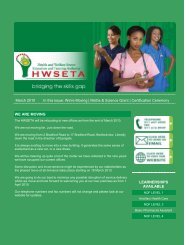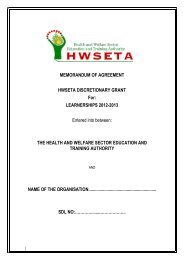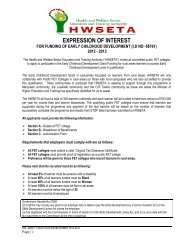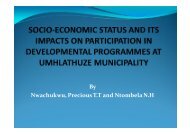sector skills plan for the health sector in south africa
sector skills plan for the health sector in south africa
sector skills plan for the health sector in south africa
Create successful ePaper yourself
Turn your PDF publications into a flip-book with our unique Google optimized e-Paper software.
organisations, to veter<strong>in</strong>ary services. In <strong>the</strong> 2009/2010 f<strong>in</strong>ancial year a total of 4 321 organisations paid<br />
<strong>skills</strong> development levies to <strong>the</strong> HWSETA.<br />
In 2010, an estimated 460 000 people are employed <strong>in</strong> <strong>the</strong> <strong>health</strong> <strong>sector</strong>, of which 179 000 (39%) are<br />
employed <strong>in</strong> private <strong>health</strong> and 281 000 (61%) <strong>in</strong> public <strong>health</strong> departments.<br />
A large portion of <strong>the</strong> workers <strong>in</strong> <strong>the</strong> <strong>health</strong> <strong>sector</strong> are registered with statutory professional councils<br />
that regulate <strong>the</strong> various professions. These councils are <strong>the</strong> Health Professions Council of South Africa<br />
(HPCSA), <strong>the</strong> South African Nurs<strong>in</strong>g Council (SANC), <strong>the</strong> South African Pharmacy Council (SAPC), <strong>the</strong><br />
Allied Health Professions Council of South Africa (AHPCSA) and <strong>the</strong> South African Dental Technicians<br />
Council (SADTC). Members of <strong>the</strong> veter<strong>in</strong>ary and para-veter<strong>in</strong>ary professions are registered with <strong>the</strong><br />
South African Veter<strong>in</strong>ary Council (SAVC) and practitioners us<strong>in</strong>g <strong>in</strong>digenous African <strong>health</strong>care<br />
techniques and medic<strong>in</strong>es will soon be required to register with <strong>the</strong> Interim Traditional Health<br />
Practitioners Council of South Africa (ITHPCSA). In many <strong>in</strong>stances <strong>the</strong>se councils determ<strong>in</strong>e <strong>the</strong> scope<br />
of practice <strong>for</strong> various <strong>health</strong> professions and en<strong>for</strong>ce rules of ethical and professional conduct. The<br />
professional councils are actively <strong>in</strong>volved <strong>in</strong> <strong>skills</strong> development through <strong>the</strong> sett<strong>in</strong>g and controll<strong>in</strong>g of<br />
standards <strong>for</strong> education and tra<strong>in</strong><strong>in</strong>g, <strong>the</strong> registration of professionals, and cont<strong>in</strong>uous professional<br />
development.<br />
In both <strong>the</strong> Public Service and <strong>in</strong> <strong>the</strong> private <strong>sector</strong> managers constitute approximately 4% of total<br />
employment. Almost half (47%) of employees <strong>in</strong> <strong>the</strong> private <strong>sector</strong> are employed as professionals and<br />
28% <strong>in</strong> <strong>the</strong> Public Service. Professionals <strong>in</strong>clude medical and dental practitioners, registered nurses,<br />
pharmacists, and o<strong>the</strong>r <strong>health</strong>-related occupations such as occupational <strong>the</strong>rapists and psychologists.<br />
Community and personal service workers <strong>in</strong> <strong>the</strong> Public Service constitute 42% of total employment. This<br />
category ma<strong>in</strong>ly comprises enrolled and auxiliary nurses, emergency service and ambulance workers and<br />
food and auxiliary hospital workers and aides.<br />
In 2010, <strong>the</strong> majority (87%) of <strong>the</strong> people work<strong>in</strong>g <strong>in</strong> <strong>the</strong> <strong>sector</strong> are black, while white workers constitute<br />
only 13% of <strong>the</strong> total work<strong>for</strong>ce. Most (63%) of <strong>the</strong> professionals employed <strong>in</strong> <strong>the</strong> total <strong>sector</strong> are<br />
African, 21% are white, 9% coloured and 7% are Indian. Among community workers and personal<br />
service workers, 80% <strong>in</strong> <strong>the</strong> private <strong>sector</strong> and 86% <strong>in</strong> <strong>the</strong> Public Service are Africans. Women constitute<br />
75% of <strong>the</strong> <strong>health</strong> work<strong>for</strong>ce and <strong>the</strong> professionals <strong>in</strong> <strong>the</strong> public <strong>sector</strong>.<br />
The majority of medical doctors/practitioners (80%), dentists (77%) and pharmacists (74%) <strong>in</strong> public<br />
<strong>health</strong> are younger than 45. More than 50% of professional nurses are 45 and older. Of <strong>the</strong> medical<br />
practitioners and specialists <strong>in</strong> <strong>the</strong> private <strong>sector</strong>, 42% are younger than 45.<br />
A number of <strong>in</strong>stitutions conduct<strong>in</strong>g research <strong>in</strong> human and animal <strong>health</strong> and <strong>the</strong> socio-economic<br />
impact of disease play a prom<strong>in</strong>ent role <strong>in</strong> <strong>the</strong> <strong>health</strong> <strong>sector</strong>. In addition to <strong>the</strong>ir research activities, <strong>the</strong><br />
Medical Research Council (MRC), National Health Laboratory Service (NHLS), Human Sciences Research<br />
Council (HSRC) and <strong>the</strong> Onderstepoort Veter<strong>in</strong>ary Institute (OVI) are specifically mandated to advance<br />
<strong>the</strong> tra<strong>in</strong><strong>in</strong>g and development of researchers, <strong>health</strong> professionals and technicians <strong>for</strong> <strong>the</strong> <strong>health</strong> <strong>sector</strong>.<br />
xi


